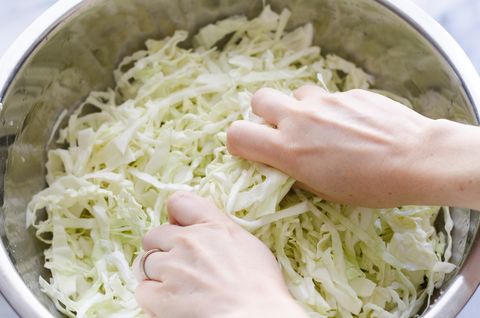Korean kimchi may be grabbing all the good publicity at the moment, but German sauerkraut, or choucroute as it’s known across the border in the French Alsace, is another fermented cabbage product that’s worthy of your attention. Like kimchi, it should ideally be consumed while still live, rather than pasteurised, which is much easier if you make it yourself.
Prep 30 min
Ferment 5 days-5 weeks
Makes 1 large jar
1 medium white cabbage (about 1kg)
1 tbsp fine salt
1 tsp juniper berries or caraway seeds (optional)
1 First pick your cabbage
Sauerkraut can be made with any sort of cabbage, but, in practice, it’s nicer with the crunchy, hard varieties – I find things like savoy and kale a bit limp for the purpose. White is traditional, but green or red will also work here; like Welsh-German food writer Anja Dunk, I think the sweeter red version is particularly good in a kraut flavoured with juniper berries.
2 Shred the cabbage
Pull off one outer leaf and set aside, then cut the cabbage into quarters and trim off the base from each wedge. Resting each quarter on a flat side, finely shred the cabbage into thin strips, clean outer leaves, core and all – a mandoline would be handy here, but a food processor tends to be too violent, because it bruises the leaves as it shreds them, so it’s worth doing it by hand for the best texture.
3 Massage salt into the cabbage
Put the shredded cabbage in a very large bowl and sprinkle with the salt. Toss well to distribute it fairly evenly, then begin vigorously massaging the salt into the leaves with your fingertips, almost as if you’re rubbing fat into flour to make pastry. Really give it some welly.
4 Then massage it some more
After a few minutes, the cabbage should start to weep. Keep going until there’s a significant amount of liquid when you press it down, which should take about 10-15 minutes in total.
If you’re really trying hard and not getting anywhere, you can add a little more salt, but that will, of course, make the end result saltier, so I’d counsel patience instead.
5 Pack into a large jar
Transfer the cabbage and the liquid it has released into a large, clean fermenting vessel – crocks are readily available in kitchen shops and online, but you can certainly use a large glass jar, if that’s all you have. Just avoid anything metal, unless it’s specifically designed for the purpose. Pack the cabbage right down as you push it into the jar; it needs to be submerged in the liquid.
6 Add the spices and/or other flavourings
At this point, add any extra flavourings: lightly bruised dried juniper berries, or caraway or yellow mustard seeds are classic choices, but you could also go for thinly sliced lemon peel, chopped dill, or other veg or fruit such as grated carrot, celeriac, apple, beetroot. Whatever you decide to use, cabbage should make up at least three-quarters of the final mix.
7 Weigh down the sauerkraut
Weigh down the cabbage so it’s completely covered by the liquid; most fermenting crocks come with weights for this purpose, but you could use the reserved outer cabbage leaf held down by a large, clean stone or a sterilised jar full of water and of an appropriate size to fit into the larger vessel.
8 Cover and leave to ferment
Cover with the lid, if using a purpose-made crock, or a clean tea-towel (the kraut needs to breathe) and leave in a cool, well-ventilated spot for between five days and five weeks, depending on how sour you want it. Keep an eye on it, to check the cabbage is still covered by liquid, and taste it occasionally to check on its progress.
9 Seal, then store or serve
Once the sauerkraut is sour enough for your liking, remove the weights, seal the jar, and refrigerate or store in a cool place. (If you find it suddenly too sour, rinse with cold water before consumption, to tone down the flavour.) Eat cold as a pickle, or warm up and eat as a side dish: it’s particularly delicious with cured meat or fish, or with creamy sauces.


